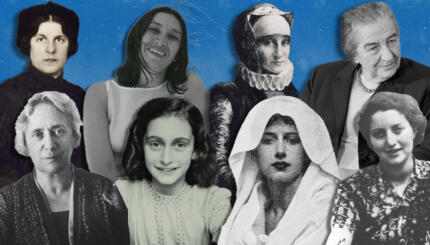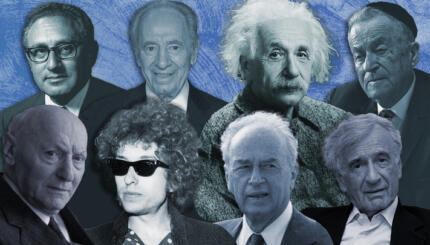Reprinted with permission from the author.
Learning Started Out Sweet
As in other aspects of Jewish culture, there was a significant difference between education in Muslim lands and in Europe, particularly Germany and France. There, the concern was of course entirely with “sacred” learning. When a boy reached the age of five or six, he was prepared for a public celebration that traditionally took place on the holiday of Shavuot (commemorating the giving of the at Mt. Sinai), at which time he was dressed in special clothes and brought to the synagogue, where he stood before the Torah while the Ten Commandments were read.
Afterward, he was presented to the teacher, who was supposed to carry him in his arms, in reference to a biblical passage (Num. 11. 12) and then present the child with a tablet, on which were inscribed the first and last four letters of the Hebrew alphabet and the verse “Moses commanded us the Torah; inheritance of the congregation of Jacob” (Deut. 33.4) and other verses. The child (presumably more than one, since all boys who attained the proper age during the year participated in the same holiday ceremony) then repeated the letters of the alphabet and the verses after the teacher.
More than a little of a superstitious nature was involved in all this, such as the repetition backwards of the last four letters, and other things. The tablet on which the letters were written was adorned with honey, which the child tasted in order to associate “sweetness” with learning. Special cakes were also prepared, or sometimes loaves of holiday bread, on which yet other biblical verses were written. The child was also given an egg to eat, again inscribed with verses (this appears to have been an imitation of a Gentile custom prevalent in Germany).

Help us keep Jewish knowledge accessible to millions of people around the world.
Your donation to My Jewish Learning fuels endless journeys of Jewish discovery. With your help, My Jewish Learning can continue to provide nonstop opportunities for learning, connection and growth.
Bilingual Immersion, Medieval Style
Actual learning began, usually, with rote repetition of the opening chapter of Leviticus, dealing with “pure” matters that were deemed appropriate for “pure” children to read. Learning of the Bible was done aloud, to a special tune (whether or not the same as used in the reading of the Torah in the synagogue is not clear from the sources). Eventually not only the Torah but also the Prophets and Writings (Hagiographa) were learned, each with its own melody. (In most cases the entire Bible was not learned, merely segments of it.)
At least in the 13th century, possibly earlier, the text was learned along with translation in the vernacular of the land (German or French), to the extent that it was possible to correctly translate the sometimes enigmatic texts given the level of knowledge of Hebrew at the time (even today scholars debate the meaning of some biblical texts, of course).
Similarly, prayers were translated into the vernacular by the father at home, and the entire Passover Haggadah was translated into French, according to the custom of Rashi and other rabbis. [Rashi (1040-1105) was the foremost French commentator of his time.] These customs have continued in Ashkenazic communities until the present time, except that Yiddish, of course, has been substituted for other languages (in modern Israel some extremely orthodox Jews still translate the Haggadah sentence for sentence into Yiddish).
No Time for the “Wisdom of the Nations”
Hebrew grammar, even after some rudimentary knowledge of it had penetrated the Franco‑German communities, was not a subject of formal study. We have no knowledge of the study of anything that might be termed “secular” studies, such as even fundamental arithmetic. Rashi(Lev. 18.4) expressed the typical hostility to secular knowledge, warning that one should not say that since he has learned Torah he may now also learn the wisdom of the nations. Apparently the learning of the vernacular was itself accomplished through the aforementioned rote translation of biblical passages, and whatever knowledge of calculation or measurements and the like would have been necessary for business purposes seems to have been acquired by “practical” learning.
The Educational Ideal, the Economic Reality
As soon as the boy had adequately “mastered” biblical study he progressed, also at an early age (which varied in theory, according to various scholars; sometimes thirteen but often earlier), directly to the study of the Talmud. This was learned, of course, from manuscript copies, which often contained erroneous or incomplete texts. Part of the study was therefore, endeavoring to arrive at a correct reading of the text being studied.
Not every rabbi was competent to make such corrections, and one of the scholars, Jacob b. Meir ( “Rabbenu Tam”),became incensed more than once with rabbis who presumed to make corrections that in fact were in error (he wrote that some rabbis should be prohibited from teaching in a yeshivah altogether). Students themselves often wrote booklets of corrected texts, with notes from their teacher’s lectures.
The ideal was for a student to continue his studies, advancing to ever-higher levels, in a yeshivah with more reputable and reliable teachers. The realities of life, of course, often precluded this. In the early medieval period, the economy of the Jewish communities was largely agricultural, and even in later centuries this was only gradually replaced by crafts and small businesses. In any case, boys were often needed by their families to work. There is simply insufficient evidence on which to base any conclusions about percentage of boys who actually were able to pursue such advanced talmudic studies. Nevertheless, some form of study was expected of a Jew throughout his life.


